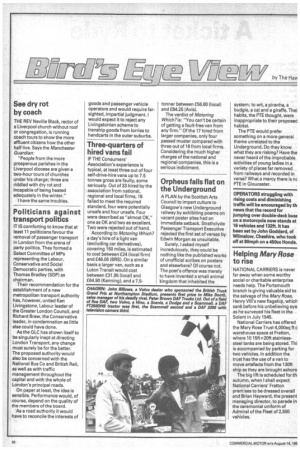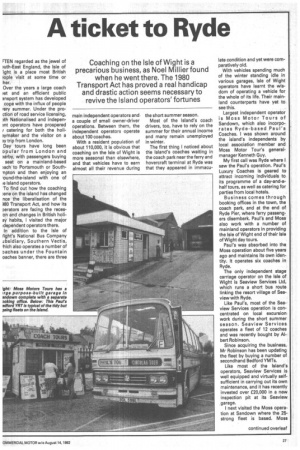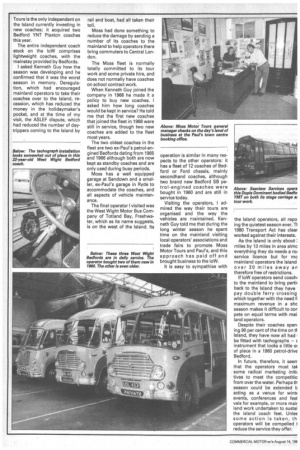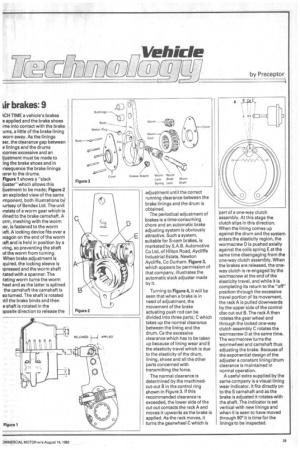Helping Mary Rose to rise
Page 18

Page 19

Page 20

Page 21

If you've noticed an error in this article please click here to report it so we can fix it.
NATIONAL CARRIERS is never far away when some worthy social or charitable enterprise needs help. The Portsmouth branch is giving valuable aid to the salvage of the Mary Rose, Henry VIII's new flagship, which sank before his unbelieving eye as he surveyed his fleet in the Solent in July 1545.
National Carriers has offered the Mary Rose Trust 4,000sq ft c warehouse space at Fratton, where 10 15ft x 20ft stainlesssteel tanks are being stored. Thi is accompanied by parking for two vehicles. In addition the trust has the use of a van to move artefacts from the 130ft ship as they are brought ashore The big lift is scheduled forth' autumn, when I shall expect National Carriers' Fratton prem:ses to be dressed overall and Brian Hayward, the present managing director, to parade in the ceremonial uniform of Admiral of the Fleet of 2,500 vehicles.
71-EN regarded as the jewel of wth-East England, the Isle of ight is a place most British )ople visit at some time or her.
Over the years a large coach let and an efficient public insport system has developed cope with the influx of people rery summer. Under the proction of road service licensing, )th Nationalised and indepenrit operators have prospered ( catering for both the holiwmaker and the visitor on a w trip from London.
Day tours have long been °pular from London and .iarby, with passengers buying seat on a mainland-based )ach to Portsmouth or Southnpton and then enjoying an .ound-the-island with one of le Island operators.
To find out how the coaching :ene on the island has changed nce the liberalisation of the )80 Transport Act, and how its aerators are facing the receson and changes in British holiay habits, I visited the major Idependent operators there.
In addition to the Isle of fight's National Bus Company ilasidiary, Southern Vectis, rhich also operates a number of Daches under the Fountain oaches banner, there are three main independent operators and a couple of small owner-driver operations. Between them, the independent operators operate about 100 coaches.
With a resident population of about 110,000, it is obvious that coaching on the Isle of Wight is more seasonal than elsewhere, and that vehicles have to earn almost all their revenue during the short summer season.
Most of the Island's coach drivers, too, have to rely on the summer for their annual income and many remain unemployed in winter.
The first thing I noticed about the Island's coaches waiting in the coach park near the ferry and hovercraft terminal at Ryde was that they appeared in immacu late condition and yet were comparatively old.
With vehicles spending much of the winter standing idle in various garages, Isle of Wight operators have learnt the wisdom of operating a vehicle for the whole of its life. Their mainland counterparts have yet to see this.
Largest independent operator is Moss Motor Tours of Sandown, which also incorporates Ryde-based Paul's Coaches. I was shown around the island's independents by local association member and Moss Motor Tour's generalmanager Kenneth Guy.
My first call was Ryde where I saw the Paul's operation. Paul's Luxury Coaches is geared to attract incoming individuals to its programme of a day-and-ahalf tours, as well as catering for parties from local hotels.
Business comes through booking offices in the town, the coach park, and at the end of Ryde Pier, where ferry passengers disembark. Paul's and Moss also work with a number of mainland operators in providing the Isle of Wight end of their Isle of Wight day tours.
Paul's was absorbed into the Moss operation about five years ago and maintains its own identity. It operates six coaches in Ryde.
The only independent stage carriage operator on the Isle of Wight is Seaview Services Ltd, which runs a short bus route linking the resort village of Seaview with Ryde.
Like Paul's, most of the Seaview Services operation is concentrated on local excursion work during the short summer season. Seaview Services operates a fleet of 12 coaches and was recently bought by Albert Robinson.
Since acquiring the business, Mr Robinson has been updating the fleet by buying a number of secondhand Bedford YMTs.
Like most of the Island's operators, Seaview Services is well equipped and virtually selfsufficient in carrying out its own maintenance, and it has recently invested over £20,000 in a new inspection pit at its Seaview garage.
I next visited the Moss operation at Sandown where the 25strong fleet is based. Moss Tours is the only independent on the Island currently investing in new coaches; it acquired two Bedford YNT Plaxton coaches this year.
The entire independent coach stock on the loW comprises lightweight coaches, with the mainstay provided by Bedfords.
I asked Kenneth Guy how the season was developing and he confirmed that it was the worst season in memory. Deregulation, which had encouraged mainland operators to take their coaches over to the Island, recession, which has reduced the money in the holidaymaker's pocket, and at the time of my visit, the ASLEF dispute, which had reduced the number of daytrippers coming to the Island by rail and boat, had all taken their toll.
Moss had done something to reduce the damage by sending a number of its coaches to the mainland to help operators there bring commuters to Central London.
The Moss fleet is normally totally committed to its tour work and some private hire, and does not normally have coaches on school contract work.
When Kenneth Guy joined the company in 1968 he made it a policy to buy new coaches. I asked him how long coaches would be kept in service? He told me that the first new coaches that joined the fleet in 1968 were still in service, though two new coaches are added to the fleet most years.
The two oldest coaches in the fleet are two ex-Paul's petrol-engined Bedfords dating from 1965 and 1966 although both are now kept as standby coaches and are only used during busy periods.
Moss has a well equipped garage at Sandown and a smaller, ex-Paul's garage in Hyde to accommodate the coaches, and all aspects of vehicle maintenance.
The final operator I visited was the West Wight Motor Bus Company of Totland Bay, Freshwater, which as its name suggests, is on the west of the Island. Its operation is similar in many respects to the other operators: it has a fleet of 12 coaches of Bedford or Ford chassis, mainly secondhand coaches, although two brand new Bedford SB pet ro 1-e ngin ed coaches were bought in 1960 and are still in service today.
Visiting the operators, I admired the way their tours are organised and the way the vehicles are maintained. Kenneth Guy told me that during the long winter season he spent time on the mainland visiting local operators' associations and trade fairs to promote Moss Motor Tours and Paul's, and this approach has paid off and brought business to the loW.
It is easy to sympathise with the Island operators, all repo ing the quietest season ever. Ti 1980 Transport Act has clear worked against their interests.
As the Island is only about miles by 13 miles in area almo everything they do needs a roi. service licence but for me mainland operators the Island over 30 miles away an therefore free of restrictions.
If loW operators send coach to the mainland to bring partil back to the Island they have pay double ferry crossing which together with the need fi maximum revenue in a she season makes it difficult to con pete on equal terms with mail land operators.
Despite their coaches speni ing 90 per cent of the time on tf Island, they have now all had 1 be fitted with tachographs — E instrument that looks a little ot of place in a 1960 petrol-drive Bedford.
In future, therefore, it seerr that the operators must tak some radical marketing inith tives to meet the competitio from over the water. Perhaps th season could be extended b acting as a venue for wintE events, conferences and fest vals for example, or more mair land work undertaken to sustai the island coach feet. Unles some action is taken, th operators will be compelled t reduce the service they offer.
kCH TIME a vehicle's brakes e applied and the brake shoes Ime into contact with the brake urns, a little of the brake lining worn away. As the linings ear, the clearance gap between e linings and the drums :comes excessive and an ljustment must be made to ing the brake shoes and in osequence the brake linings rarer to the drums.
Figure 1 shows a "slack ljuster" which allows this ljustment to be made; Figure 2 an exploded view of the same mponent, both illustrations by surtesy of Bendex Ltd. The unit insists of a worm gear which is dined to the brake camshaft. A orm, meshing with the worm par, is fastened to the worm left. A locking device fits over a sxagon on the end of the worm 'aft and is held in position by a sring, so preventing the shaft id the worm from turning. When brake adjustment is quired, the locking sleeve is :pressed and the worm shaft tated with a spanner. The ,tating worm turns the worm heel and as the latter is splined the camshaft the camshaft is so turned. The shaft is rotated WI the brake binds and then e shaft is rotated in the
mosite direction to release the adjustment until the correct running clearance between the brake linings and the drum is obtained.
The periodical adjustment of brakes is a time-consuming chore and an automatic brake adjusting system is obviously attractive. Such a system, suitable for S-cam brakes, is marketed by S.A.B. Automotive Co Ltd, of Hilton Road, Aycliffe Industrial Estate, Newton Aycliffe, Co Durham. Figure 3, which appears by permission of that company, illustrates the automatic slack adjuster made by it.
Turning to Figure 4, it will be seen that when a brake is in need of adjustment, the movement of the brake actuating push rod can be divided into three parts; C which takes up the normal clearance between the lining and the drum. Ce the excessive clearance which has to be taken up because of lining wear and E the elasticity travel which is due to the elasticity of the drum, lining, shoes and all the other parts concerned with transmitting the force.
The normal clearance is determined by the machinedcut-out B in the control ring shown in Figure 3. If this recommended clearance is exceeded, the lower side of the cut out contacts the rack A and moves it upwards as the brake is applied. As the rack moves, it turns the gearwheel C which is part of a one-way clutch assembly. At this stage the clutch slips in this direction. When the lining comes up against the drum and the system enters the elasticity region, the wormscrew D is pushed axially against the coils spring E at the same time disengaging from the one-way clutch assembly. When the brakes are released, the oneway clutch is re-engaged by the wormscrew at the end of the elasticity travel, and while it is completing its return to the "off" position through the excessive travel portion of its movement, the rack A is pulled downwards by the upper side of the control disc cut out B. The rack A then rotates the gear wheel and through the locked one-way clutch assembly C rotates the wormscrew D at the same time. The wormscrew turns the wormwheel and camshaft thus adjusting the brake. Because of the exponential design of the adjuster a constant lining/drum clearance is maintained in normal operation.
A useful extra supplied by the same company is a visual lining wear indicator. It fits directly on to the S camshaft and as the brake is adjusted it rotates with the shaft. The indicator is set vertical with new linings and when it is seen to have moved through 900 it is time for the linings to be inspected.














































